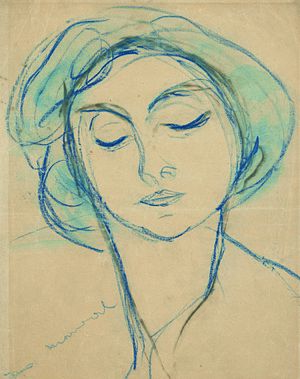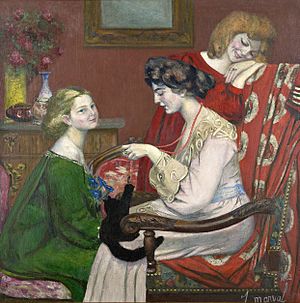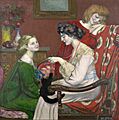Jacqueline Marval facts for kids
Quick facts for kids
Jacqueline Marval
|
|
|---|---|

Self-portrait
|
|
| Born |
Marie Josephine Vallet
19 October 1866 Quaix-en-Chartreuse, France
|
| Died | 1932 Paris, France
|
| Nationality | French |
| Known for | Painting |
| Spouse(s) | Albert Valentin (m. 1886 - d. 1891) |
| Partner(s) | François Joseph Girot, Jules Flandrin |
Jacqueline Marval was the artist name used by Marie Josephine Vallet (born October 19, 1866 – died May 28, 1932). She was a French artist who created paintings, lithographs, and sculptures.
Contents
Early Life and New Beginnings
Marie Josephine Vallet was born in Quaix-en-Chartreuse, France. Her family worked as school teachers. She got married in 1886 to Albert Valentin, who was a traveling salesperson. In 1891, she separated from her husband. After this, she worked as a seamstress to support herself. In 1900, Marie Josephine Vallet chose a new name for her art career: Jacqueline Marval. She created "Marval" by combining parts of her first and last names: "MARie VALlet."
Becoming a Professional Artist
In 1894, Marval met another painter named François Joseph Girot. She moved to Paris to live with him. Through Girot, she met a group of artists called Les Nabis. She also met Jules Flandrin, who was another painter. Marval and Flandrin fell in love. She then moved to live with Flandrin in the Montparnasse area of Paris. They lived together for 20 years.
Marval mostly worked as a painter. However, she also created many other types of art. These included lithographs (prints made from stone), watercolors, pastels, engravings, and designs for tapestries. She even tried making sculptures.
First Art Shows
Marval's first artworks were not accepted into the 1900 Salon des Indépendants art show. But she did not give up! The very next year, in 1901, she successfully showed twelve of her paintings at the same exhibition. An art dealer named Ambroise Vollard bought the paintings that were rejected in 1900. He continued to support her art throughout her career.
Between 1901 and 1905, Marval often worked with famous artists like Henri Matisse, Albert Marquet, and Jules Flandrin. They all influenced each other's artistic styles.
In 1902, some of Marval's paintings were shown in a gallery in Paris. This gallery was run by Berthe Weill, who was very interested in helping female artists in Paris. Marval also showed her large painting, Les Odalisques, at the first Salon d'Automne in 1902.
Decorating a Famous Theater
In 1913, Jacqueline Marval was chosen for a special project. A group of important artists and sculptors picked her to decorate the lobby of the new Théâtre des Champs-Élysées. This was a very important theater in Paris. She created a series of twelve paintings. These paintings were inspired by the story of Daphnis and Chloe. This story had been performed by the Ballets Russes (a famous dance company) the year before.
Also in 1913, Marval spoke out against a painting being removed from the Salon d'Automne. This painting was The Spanish Shawl by Kees van Dongen. Marval and Van Dongen became friends. In 1914, Marval and Flandrin moved their art studio next door to Van Dongen's studio.
Art Around the World
Jacqueline Marval's art became known in many places. She showed her works in cities across Europe, including Barcelona, Liège, Venice, Zurich, and Budapest. Her art even traveled as far as Kyoto, Japan!
Starting in 1923, Marval worked to help create modern art museums in Paris and Grenoble. She passed away in Paris in 1932. After her death, her paintings were kept at the Galerie Druet. One of her paintings, Portrait of Dolly Davis (from 1925), is now part of the collection at the Milwaukee Art Museum.
Marval's paintings are known for being bold and unique. She was an important artist during the early days of modern art.
Les Odalisques, a Famous Work
Perhaps Marval's most famous painting is Les Odalisques. She created it between 1902 and 1903. It was first shown at the Salon des Indépendants in 1903.
A famous writer named Guillaume Apollinaire was very impressed by this painting. In 1912, he wrote that Marval had shown her great talent with this work. He said it was strong, full of feeling, and very original in its design, lines, and colors. He believed it deserved to be remembered.
Today, Les Odalisques is part of the collection at the Musée de Grenoble. It was last shown in an exhibition at the Musée Paul-Dini in 2018.
It's often said that Les Odalisques was shown at the important 1913 Armory Show in the United States. However, this is not correct. Instead, a different painting by Marval, Odalisques au miroir (from 1911), was shown there. Ambroise Vollard had invited her to exhibit this work. Marval showed her art in the United States several more times after the Armory Show.
Images for kids
See also
 In Spanish: Jacqueline Marval para niños
In Spanish: Jacqueline Marval para niños




